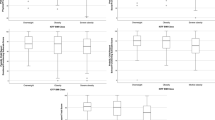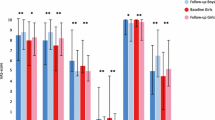Abstract
Purpose
Poor quality of life has been shown to occur in youth with obesity. This study aimed to assess associations between health-related quality of life, general mental health and general psychological distress measures, collectively termed psychosocial health questionnaires (PSH), with weight outcomes in a busy paediatric weight management service.
Methods
A cross-sectional longitudinal clinical cohort, ‘Childhood Overweight BioRepository of Australia (COBRA)’, was used (n = 250, median age 11, range 2–18 year, mean BMI z-score 2.5 ± 0.2). Clinical data were collected and HRQOL questionnaires; Pediatric Quality of Life 4.0 (PedsQL), ‘Sizing Me/Them Up’ (SMU/STU), and psychological well-being questionnaires; strengths and difficulties questionnaire (SDQ) and Kessler 10 (K10) were completed by the child and primary caregiver. PSH results were compared to age- and sex-adjusted BMI z-score at baseline and follow-up. Direct logistic regression modelling was performed to assess the impact of PSH factors on the likelihood of successful weight reduction over a period of ≥ 12 months.
Results
Mean self-report PSH scores were: 68.0 ± 15.28 (PedsQL, range 0-100), 64.8 ± 15.8, (SMU, range 0-100), 17.3 ± 4.4 (SDQ, range 0–40) and 20.0 ± 7.7 (K10, range 0–50). A significant negative correlation was observed between PSH scores and childhood obesity (baseline BMI z-scores (p < 0.01)). No correlations were observed between psychological well-being measures and BMI z-scores. Higher subscale scores of the PedsQL and SDQ, which measure impaired psychosocial health and more difficulties with hyperactivity and inattention, significantly predict weight loss in children with obesity after 12 months.
Conclusion
PSH questionnaires may be useful in identifying individuals who require additional support to achieve weight loss goals in a tertiary weight management service.

Similar content being viewed by others
References
Olds, T. S., et al. (2010). Trends in the prevalence of childhood overweight and obesity in Australia between 1985 and 2008. International Journal of Obesity, 34(1), 57–66.
Organization, W. H., (2007). International classification of functioning, disability and health: Children and youth version: ICF-CY. Geneva: WHO Press.
Schwimmer, J. B., Burwinkle, T. M., & Varni, J. W. (2003). Health-related quality of life of severely obese children and adolescents. JAMA, 289(14), 1813–1819.
Stern, M., et al. (2007). Gender, ethnicity, psychosocial factors, and quality of life among severely overweight, treatment-seeking adolescents. Journal of Pediatric Psychology, 32(1), 90–94.
Varni, J. W., Seid, M., & Kurtin, P. S. (2001). PedsQL 4.0: Reliability and validity of the pediatric quality of life inventory version 4.0 generic core scales in healthy and patient populations. Medical Care, 39(8), 800–812.
Goodman, A., & Goodman, R. (2009). Strengths and difficulties questionnaire as a dimensional measure of child mental health. Journal of the American Academy of Child & Adolescent Psychiatry, 48(4), 400–403.
Kessler, R. C., et al. (2003). Screening for serious mental illness in the general population. Archives of General Psychiatry, 60(2), 184–189.
Zeller, M. H., & Modi, A. C. (2009). Development and initial validation of an obesity-specific quality-of-life measure for children: Sizing me up. Obesity, 17(6), 1171–1177.
Kolotkin, R. L., & Crosby, R. D. (2002). Psychometric evaluation of the impact of weight on quality of life-lite questionnaire (IWQOL-lite) in a community sample. Quality of Life Research, 11(2), 157–171.
de Beer, M., et al. (2007). Health-related-quality-of-life in obese adolescents is decreased and inversely related to BMI. Acta Paediatrica, 96(5), 710–714.
Hughes, A. R., et al. (2007). Quality of life in a clinical sample of obese children. International Journal of Obesity, 31(1), 39–44.
Pinhas-Hamiel, O., et al. (2006). Health-related quality of life among children and adolescents: Associations with obesity. International Journal of Obesity, 30(2), 267–272.
Swallen, K. C., et al. (2005). Overweight, obesity, and health-related quality of life among adolescents: The national longitudinal study of adolescent health. Pediatrics, 115(2), 340–347.
Tyler, C., et al. (2007). Reduced quality of life in very overweight Mexican American adolescents. Journal of Adolescent Health, 40(4), 366–368.
Zeller, M. H., & Modi, A. C. (2006). Predictors of health-related quality of life in obese youth. Obesity, 14(1), 122–130.
Williams, J., et al. (2005). Health-related quality of life of overweight and obese children. JAMA, 293(1), 70–76.
Ravens-Sieberer, U., Redegeld, M., & Bullinger, M. (2001). Quality of life after in-patient rehabilitation in children with obesity. International Journal of Obesity and Related Metabolic Disorders, 25(Suppl 1), S63–S65.
Russell-Mayhew, S., et al. (2012). Mental health, wellness, and childhood overweight/obesity. Journal of Obesity, 2012, 281801.
Frohlich, G., et al. (2011). Conditions of long-term success in a lifestyle intervention for overweight and obese youths. Pediatrics, 128(4), e779–e785.
Reinehr, T., et al. (2007). Four-year follow-up of children and adolescents participating in an obesity intervention program. International Journal of Obesity, 31(7), 1074–1077.
van Egmond-Froehlich, A., et al. (2012). The hyperactivity/inattention subscale of the strengths and difficulties questionnaire predicts short- and long-term weight loss in overweight children and adolescents treated as outpatients. Obesity Facts, 5(6), 856–868.
van Egmond-Froehlich, A., et al. (2013). Parent reported inattention and hyperactivity/impulsivity as predictor of long-term weight loss after inpatient treatment in obese adolescents. International Journal of Eating Disorders, 46(1), 39–46.
Ryder, J. R., et al. (2018). Factors associated with long-term weight-loss maintenance following bariatric surgery in adolescents with severe obesity. International Journal of Obesity, 42(1), 102–107.
Sabin, M. A., et al. (2010). New directions in childhood obesity research: How a comprehensive biorepository will allow better prediction of outcomes. BMC Medical Research Methodology, 10, 100.
Cole, T. J. (1990). The LMS method for constructing normalized growth standards. European Journal of Clinical Nutrition, 44(1), 45–60.
Marshall, W. A., & Tanner, J. M. (1969). Variations in pattern of pubertal changes in girls. Archives of Disease in Childhood, 44(235), 291–303.
Marshall, W. A., & Tanner, J. M. (1970). Variations in the pattern of pubertal changes in boys. Archives of Disease in Childhood, 45(239), 13–23.
Ogden, C. L., et al.(2004) Mean body weight, height, and body mass index, United States 1960–2002. Advance Data, 347(347), 1–17.
Modi, A. C., & Zeller, M. H. (2008). Validation of a parent-proxy, obesity-specific quality-of-life measure: Sizing them up. Obesity, 16(12), 2624–2633.
Harris, P. A., et al. (2009). Research electronic data capture (REDCap)--a metadata-driven methodology and workflow process for providing translational research informatics support. Journal of Biomedical Informatics, 42(2), 377–381.
Parks, E. P., et al. (2012). Influence of stress in parents on child obesity and related behaviors. Pediatrics, 130(5), e1096–e1104.
Koch, F. S., Sepa, A., & Ludvigsson, J. (2008). Psychological stress and obesity. The Journal of pediatrics, 153(6), 839–844.
Tsiros, M. D., et al. (2009). Health-related quality of life in obese children and adolescents. International Journal of Obesity, 33(4), 387–400.
Pratt, K. J., et al. (2012). The importance of assessing for depression with HRQOL in treatment seeking obese youth and their caregivers. Quality Life Research, 21(8), 1367–1377.
Riazi, A., et al. (2010). Health-related quality of life in a clinical sample of obese children and adolescents. Health and Quality of Life Outcomes, 8, 134.
Wake, M., et al. (2010). Comorbidities of overweight/obesity experienced in adolescence: Longitudinal study. Archives of Disease in Childhood, 95(3), 162–168.
Williams, J. W., et al. (2011). Changes in body mass index and health related quality of life from childhood to adolescence. International Journal of Pediatric obesity, 6(2–2), e442–e448.
Black, W. R., et al. (2014). Health-related quality of life in obese and overweight, treatment-seeking youth. Ethnicity & Disease, 24(3), 321–327.
Guilfoyle, S. M., Zeller, M. H., & Modi, A. C. (2010). Parenting stress impacts obesity-specific health-related quality of life in a pediatric obesity treatment-seeking sample. Journal of Developmental and Behavioral Pediatrics: JDBP, 31(1), 17–25.
Nir, Z., & Neumann, L. (1995). Relationship among self-esteem, internal-external locus of control, and weight change after participation in a weight reduction program. Journal of Clinical Psychology, 51(4), 482–490.
Ingerski, L. M., Janicke, D. M., & Silverstein, J. H. (2007). Brief report: quality of life in overweight youth-the role of multiple informants and perceived social support. Journal of Pediatric Psychology, 32(7), 869–874.
Fonseca, H., et al. (2009). Are overweight and obese adolescents different from their peers? International Journal of Pediatric Obesity, 4(3), 166–174.
Zeller, M. H., Reiter-Purtill, J., & Ramey, C. (2008). Negative peer perceptions of obese children in the classroom environment. Obesity, 16(4), 755–762.
Strauss, R. S., & Pollack, H. A. (2003). Social marginalization of overweight children. Archives of Pediatrics & Adolescent Medicine, 157(8), 746–752.
Lebacq, T., et al. (2018) Perceived social support from teachers and classmates does not moderate the inverse association between body mass index and health-related quality of life in adolescents. Quality Life Research. https://doi.org/10.1007/s11136-018-2079-x.
Puhl, R. M., & Heuer, C. A. (2010). Obesity stigma: important considerations for public health. American Journal of Public Health, 100(6), 1019–1028.
Acknowledgements
The authors would like to thank the COBRA participants and their families. Authors from the Murdoch Childrens Research Institute are supported in part by the Victorian Government Operational Infrastructure Support Program. BEH is an NHMRC Peter Doherty ECF Fellow (Grant No. APP:1072086).
Funding
Funding for this project was received from the National Health and Medical Research Council Australia (Grant No. APP:1072086) and additionally supported by the Victorian Government Operational Infrastructure Support Program.
Author information
Authors and Affiliations
Corresponding author
Ethics declarations
Conflict of interest
The authors have no conflicts of interest to declare in relation to this study.
Ethics approval
This study was approved by and conducted in accordance with guidelines stipulated by, The Royal Children’s Hospital Human Research Ethics Committee and with the 1964 Helsinki declaration and its later amendments (RCH HREC Ref#28081, Melbourne, Australia).
Informed consent
Informed consent was obtained from all participants included in this study.
Additional information
Publisher’s Note
Springer Nature remains neutral with regard to jurisdictional claims in published maps and institutional affiliations.
Electronic supplementary material
Below is the link to the electronic supplementary material.
Rights and permissions
About this article
Cite this article
Harcourt, B.E., Pons, A., Kao, KT. et al. Psychosocial measures and weight change in a clinical paediatric population with obesity. Qual Life Res 28, 1555–1564 (2019). https://doi.org/10.1007/s11136-019-02155-3
Accepted:
Published:
Issue Date:
DOI: https://doi.org/10.1007/s11136-019-02155-3




